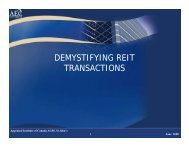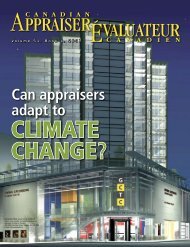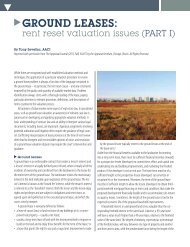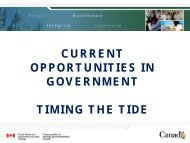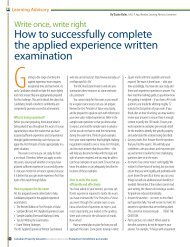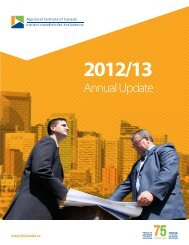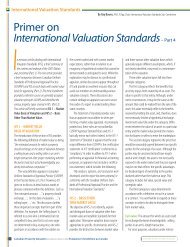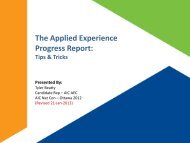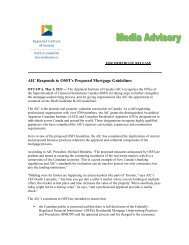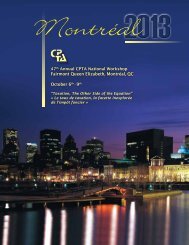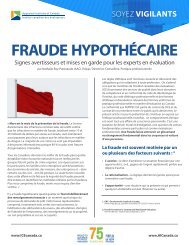Book 2 - Appraisal Institute of Canada
Book 2 - Appraisal Institute of Canada
Book 2 - Appraisal Institute of Canada
You also want an ePaper? Increase the reach of your titles
YUMPU automatically turns print PDFs into web optimized ePapers that Google loves.
Undue appraiser influence takes many forms.<br />
At the very low end, when an appraiser receives<br />
a request from an appraisal management company<br />
or a lender stating what the value <strong>of</strong> the<br />
property is, or should be, this may be considered<br />
as improper influence. See CUSPAP Ethics Standard<br />
Comment 5.14 for a discussion on this issue. As<br />
a pr<strong>of</strong>essional, you are expected to ignore these<br />
statements and to produce your report in an<br />
unbiased manner. It would be inappropriate for you<br />
to contact your client to say that you are unable<br />
to confirm their preconceived notion <strong>of</strong> value and<br />
seek further instructions.<br />
In the middle ground, there may be the<br />
perception that a client’s instructions may alter<br />
the definition <strong>of</strong> fair market value, or unduly<br />
restrict you in some fashion. For example, they<br />
might suggest that you are only permitted to use<br />
a comparable within a certain geographic radius<br />
<strong>of</strong> the subject property or that the adjustments<br />
cannot exceed a predetermined percentage. As a<br />
pr<strong>of</strong>essional, you should endeavour to satisfy your<br />
client’s request, however, where it is not possible,<br />
it is important to recognize that it is your pr<strong>of</strong>essional<br />
opinion <strong>of</strong> value and that, in your report,<br />
you should set out the ways in which this criteria<br />
affected market value or how difficult this made<br />
the assignment. It would be inappropriate for you<br />
to simply comply with these requests without an<br />
independent analysis <strong>of</strong> market conditions.<br />
The high end <strong>of</strong> undue appraiser influence may<br />
be where your client directs you to use a specific<br />
comparable or to rely on unsubstantiated facts,<br />
or makes a suggestion that failure to meet the<br />
client’s value requirements may affect your ability<br />
to earn a livelihood. As a pr<strong>of</strong>essional, your ethical<br />
obligation is to confront these challenges to your<br />
integrity and to not succumb to them. It would be<br />
inappropriate to react to these intimidations and<br />
it is reasonable for you to decline any assignment<br />
where you are uncomfortable with the pressures<br />
being placed on you.<br />
The suggestion that failure to meet a client’s<br />
demands may result in a complaint to the <strong>Institute</strong><br />
may also be perceived as a form <strong>of</strong> undue influence.<br />
However, you should always welcome a<br />
review by the <strong>Institute</strong> and welcome the opportunity<br />
to publicly expose those who would attempt<br />
to unduly influence the appraisal process.<br />
If an appraiser is concerned about undue influence,<br />
he or she may contact the Counsellor Pr<strong>of</strong>essional<br />
Practice via email Counsellor@aicanada.ca or<br />
toll free 866-726-5996.<br />
Real Estate Fraud Task Force<br />
George Maurice, AACI, P. App – Chair<br />
Paula Malcolm-Schaller, CRA<br />
Kimberly Maber, AACI, P. App<br />
Ed Saxe, CRA<br />
George Ward, AACI, P. App<br />
To contact this committee by email<br />
fraudinfo@aicanada.ca<br />
Each <strong>of</strong> these may be viewed as<br />
examples <strong>of</strong> undue appraiser influence:<br />
(1) by improper influence, through coercion,<br />
extortion, collusion, compensation,<br />
instruction, inducement, intimidation,<br />
or bribery from a party with a<br />
direct interest in the property or the<br />
transaction;<br />
(2) by influence <strong>of</strong> an appraiser or otherwise<br />
encouraging a pre-determined value, a<br />
direction in value, or a specific result;<br />
(3) by any suggestion that an appraiser’s<br />
livelihood may be jeopardized including<br />
non-payment, failure to timely<br />
compensate an appraiser for work<br />
completed or denial <strong>of</strong> future work; and<br />
(4) by threat or intimidation <strong>of</strong> the<br />
submission <strong>of</strong> a complaint to the<br />
<strong>Institute</strong>, if a pre-determined value, a<br />
direction in value, or a specific result is<br />
not obtained.<br />
Canadian Property Valuation Volume 52 | book 2 | 2008 Évaluation Immobilière au <strong>Canada</strong> 33



